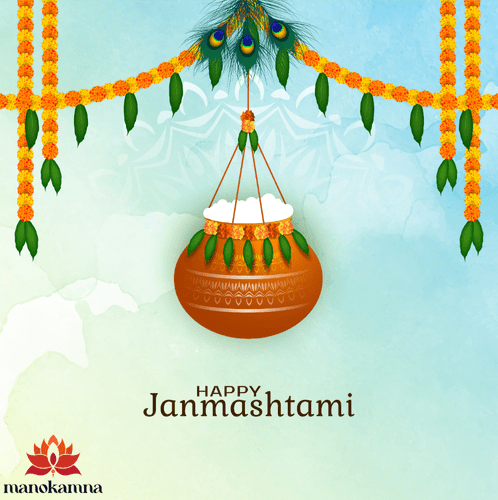
Janmashtami, also known as Krishna Janmashtami or Gokulashtami, is one of the most widely celebrated Hindu festivals, marking the birth of Lord Krishna, the eighth avatar of Vishnu. This auspicious day falls on the Ashtami (eighth day) of the Krishna Paksha (dark fortnight) in the month of Bhadrapada, which typically corresponds to August or September in the Gregorian calendar. Janmashtami is celebrated with immense devotion, joy, and enthusiasm across India and other parts of the world where Hindu communities reside.
Historical and Mythological Significance
The story of Krishna’s birth is a significant chapter in Hindu mythology. According to the Bhagavata Purana, Krishna was born in a prison cell in Mathura at midnight to Devaki and Vasudeva. Devaki’s brother, the tyrant King Kansa, had been forewarned by a divine prophecy that Devaki’s eighth child would bring about his downfall. Fearing this, Kansa imprisoned Devaki and Vasudeva and killed their first seven children. However, when Krishna was born, the prison gates miraculously opened, and Vasudeva was able to carry the newborn to safety in Gokul, across the river Yamuna, to Nanda and Yashoda. This event marks the beginning of Krishna’s life and his many divine adventures and teachings.
Krishna’s life and deeds are chronicled in various ancient scriptures, including the Mahabharata, the Bhagavad Gita, and numerous Puranas. He is revered for his teachings, his role in the epic battle of Kurukshetra, his divine play (leelas) with the Gopis of Vrindavan, and his philosophical discourse in the Bhagavad Gita, which continues to guide and inspire millions around the world.
Celebrations Across India
Janmashtami is celebrated differently across various regions of India, reflecting the diverse cultural practices and traditions.
Mathura and Vrindavan: Mathura, the birthplace of Krishna, and Vrindavan, where he spent his childhood, are the epicenters of Janmashtami celebrations. The festivities here are marked by grand processions, dramatic enactments of Krishna’s life (Raslila), devotional songs and dances, and elaborate decorations in temples. Devotees flock to these holy towns to participate in the midnight ceremonies and seek blessings.
Maharashtra: In Maharashtra, Janmashtami is synonymous with the energetic Dahi Handi celebrations. This tradition involves forming human pyramids to break a high-hanging pot of curd, symbolizing Krishna’s playful and mischievous nature as Makhan Chor (butter thief). The event is accompanied by much cheer, music, and competition, drawing large crowds.
Gujarat: In Gujarat, particularly in Dwarka, the city associated with Krishna’s later life, Janmashtami is celebrated with great fervor. Temples are decorated beautifully, and special prayers and bhajans are performed. The Dwarkadhish Temple in Dwarka becomes the focal point of celebrations.
Northern India: In states like Uttar Pradesh, Delhi, Punjab, and Haryana, temples and homes are decorated, and devotees observe fasts and perform night-long vigils. The Bhagavad Gita is recited, and various cultural programs depicting Krishna’s life are held.
South India: In South India, particularly in Tamil Nadu and Karnataka, devotees decorate their homes with kolams (rangoli) and place small footprints made from rice flour leading to their prayer rooms, symbolizing Krishna’s childhood playfulness. Temples organize special prayers, and cultural programs are held to mark the occasion.
Rituals and Traditions
Janmashtami rituals and traditions are rich and varied, reflecting the deep devotion and reverence for Lord Krishna.
Fasting: Many devotees observe a fast on Janmashtami, refraining from food and water until the midnight hour when Krishna is believed to have been born. This fast is broken with special prasad (offerings) made to the deity.
Abhishekam: At midnight, idols of baby Krishna are bathed (abhishekam) with milk, honey, ghee, and water, symbolizing the purification and welcoming of the divine child. The idol is then placed in a cradle and rocked gently to the accompaniment of devotional songs and chants.
Decoration and Lighting: Temples and homes are decorated with flowers, lights, and rangoli. Special altars are set up with Krishna idols, often depicting scenes from his early life. Lamps and candles are lit to signify the dispelling of darkness.
Raslila and Dramas: In many parts of India, especially in Mathura and Vrindavan, dramatic enactments of Krishna’s life, known as Raslila, are performed. These plays and dances bring to life the various episodes from Krishna’s childhood and youth, capturing his divine leelas and teachings.
Singing and Chanting: Devotees engage in singing bhajans (devotional songs) and chanting Krishna’s name throughout the day and night. The Hare Krishna mantra is particularly popular during this time: “Hare Krishna, Hare Krishna, Krishna Krishna, Hare Hare, Hare Rama, Hare Rama, Rama Rama, Hare Hare.”
Special Prasadam: Special dishes are prepared as offerings to Lord Krishna. These include sweets like laddus, peda, and kheer, as well as savory items like poha and butter, reflecting Krishna’s love for milk products. These offerings are later distributed among devotees as prasad.
Significance of Janmashtami
Janmashtami holds profound spiritual significance for Hindus. It is a time to reflect on the teachings and philosophy of Lord Krishna, as expounded in the Bhagavad Gita. Krishna’s life exemplifies the principles of dharma (righteousness), karma (duty), and bhakti (devotion).
Dharma and Righteousness: Krishna’s role in the Mahabharata and his guidance to Arjuna on the battlefield of Kurukshetra emphasize the importance of performing one’s duty without attachment to the results. This principle of nishkama karma (selfless action) is a cornerstone of Krishna’s teachings.
Divine Play (Leela): Krishna’s life is a divine play filled with miraculous deeds and charming leelas. His childhood stories, such as lifting the Govardhan Hill to protect the villagers from torrential rains and his playful antics with the Gopis, illustrate his divine nature and his role as a protector and guide.
Bhakti and Devotion: Krishna’s teachings underscore the significance of bhakti (devotion) as a means to attain spiritual enlightenment and liberation. His interactions with his devotees, particularly the Gopis, highlight the pure and selfless love that leads to union with the divine.
Moksha (Liberation): The Bhagavad Gita, Krishna’s discourse to Arjuna, addresses the path to moksha (liberation) through knowledge, action, and devotion. It offers profound insights into the nature of the self, the universe, and the ultimate reality.
Conclusion
Janmashtami is a celebration that transcends mere ritualistic worship. It is an occasion to immerse oneself in the divine love and wisdom of Lord Krishna. The festival brings together communities, fosters cultural expressions, and reinforces the timeless values of dharma, devotion, and duty.
As devotees across the world prepare to celebrate Janmashtami, they are reminded of Krishna’s eternal message of love, compassion, and righteousness. Through fasting, prayer, and joyous celebrations, they seek to connect with the divine and imbibe the virtues exemplified by Lord Krishna in their own lives.
The festival of Janmashtami thus serves as a beacon of light, guiding humanity on the path of truth, justice, and spiritual fulfillment. It is a time to rejoice in the birth of the divine child who continues to inspire and uplift the hearts and souls of millions.
